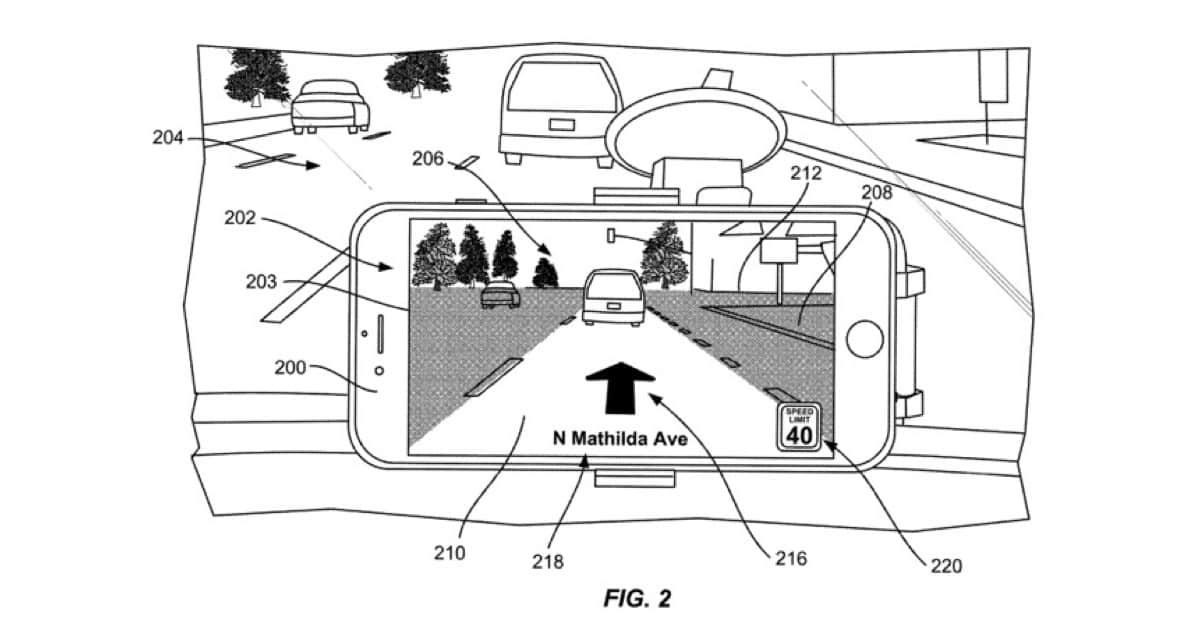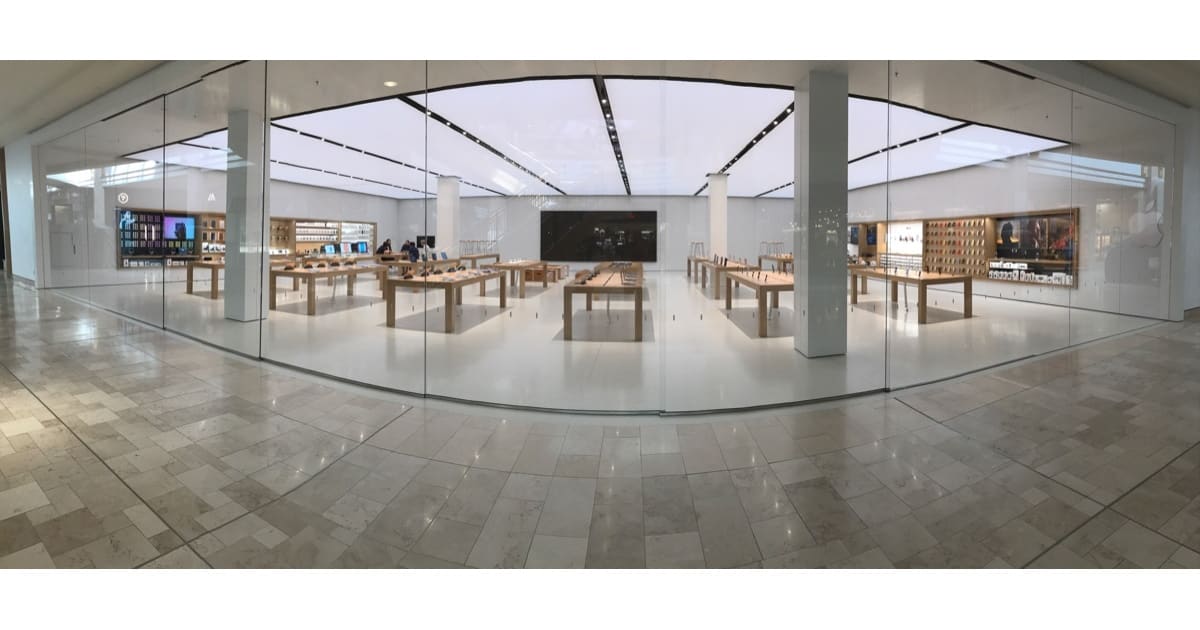Combining AR with maps navigation has been an obvious use case for a long time now. AppleInsider explores the possibilities. “Apple Maps may add AR view highlighting the route ahead while driving.”

In a patent application titled “Navigation using Augmented Reality” published by the US Patent and Trademark Office on Thursday, Apple believes it can provide better visual information to the driver, by taking advantage of AR.
While this may be one of those defensive patents, I really think this concept is right up Apple’s alley. However…
Recently, I was driving a 2019 rental with a really large, exotic LCD display. Full of features. I had to force myself to keep my eyes on the road. And so, my current belief is that AR + maps has to be in a head-up display, superimposed on the windshield, just as jet pilots do it. Looking at an iPhone while driving, mesmerized, changing focus from far to near and back, no matter how cool the AR effects are, is just asking for trouble.
Just like pilots, eyeballs need to be mostly outside the cockpit. Apple’s desire to sell cool iPhones must be subservient to this safety issue while driving. Indeed, car makers need to develop an AirPlay interface to the windshield head-up system to make this happen, and Apple should promote the usage, if the patent becomes reality, in that manner.
More News Debris
• Social media has the continuing capacity to surprise us and affect our culture. Often that’s in negative ways. This extensive excerpt at Wired from The End of Forgetting: Growing Up with Social Media by Kate Eichhorn is both fascinating and scary. You’ll find tidbits of startling insights that don’t often appear in everyday tech journalism. Buckle up and get your head ready for: “Social Media Could Make It Impossible To Grow Up.”
• With iTunes gone in the coming macOS Catalina, it’s important to know how to handle iOS device back up operations. Roman Loyola at MacWorld walks us through it. “How you back up your iPhone and iPad in macOS 10.15 Catalina.”
• The current iPhone motif for 2019 is that, without 5G, sales will suffer badly. But we know better. Other issues come into play, as described by Debby Wu, Yuan Gao, and Mark Gurman at Bloomberg. See: “Apple Suppliers See Demand for New IPhones Stabilizing This Year.” As always, if you need a new iPhone this year, buy one. If not, it can wait. Which leads me to….
• Here’s the latest on the iPhone 11 rumors. “Apple iPhone 11 will have Lightning connector, new camera features, ditch 3D Touch: Report.”

• Another current motif is that Apple will soon take some Macs to the A-series ARM CPUs. Jason Snell gives us some preparatory background. “How a 16-inch MacBook Pro sets the table for ARM MacBooks.” Along the way, author Snell sizes up Apple’s MacBook/Air/Pro lineup.
As much as I love the current-model MacBook Air, it is literally the only consumer-grade laptop Apple sells today. Apple seems to have spend the last couple of years cleaning up the mess it made in miscalculating the appeal of the 12-inch MacBook and the 13-inch MacBook Pro, which is admirable—but right now, if you don’t want to pay for a MacBook Pro, all you’re left with is the Air.
It could well be that we’ll see some A-series MacBooks of some kind with new, scissors mechanism keyboards in 2020. Wouldn’t that be glorious?
Particle Debris is a generally a mix of John Martellaro’s observations and opinions about a standout event or article(s) of the week followed by a discussion of articles that didn’t make the TMO headlines, the technical news debris. The column is published most every Friday except for holiday weeks.
John:
Very thoughtful picks, as usual.
Regarding the iPhone on the dash vs HUD, assuming that we don’t move to a totally automated driverless car paradigm first, making either option moot, the future is clearly with AR and augmented visuals which will enhance driver senses and perception without removing their eyes from the road. Think Star Trek and the view screen. With a bit of retconning, we now know that those visuals of space phenomena, like shields, quantum singularities, space rifts (whatever those are) and graviton waves (gravity waves are real https://en.wikipedia.org/wiki/First_observation_of_gravitational_waves, gravitons have yet to be proved https://en.wikipedia.org/wiki/Graviton) were augmented reality brought to the screen by the ship’s AI in order for the human crew to visually perceive. It takes little imagination to translate this, using available technology, into a HUD on the screen that not simply displays the route, but enhances visualisation, particularly during inclement weather. Imagine being able to see through fog or heavy rain with an AR – enhanced screen. Your car already can, if you have adaptive cruise control, proximity and lane-change alert. That and similar current tech could be ported to your AR-enhanced windscreen enabling you to see where other cars, their trajectories, obstacles and the road itself are when normal visual light is compromised. The computational power is already there in your iPhone; why could it not be housed in your car or ported from the iPhone to the car’s onboard system? Of course it could. What I wouldn’t mind having is Nick Fury’s onboard system where I could simply say, ‘Take over the wheel’, ‘Give me the wheel’ or ‘Go airborne!’ at will.
Kate Eichorn’s piece on social media making it impossible to grow up highlights the complexity of progress in an age in which the pace of our technological progress outstrips that of both our legislative and cultural progress. That in the 16th Century “there were no age-based grades or corresponding books. New readers, whether they were 5 or 35, were expected to read the same basic books. By the late 18th century, however, the world had changed…” as she cites, should not be construed as either a value judgement or a guide as to how we grapple with realtime global exposure of our personal lives online, and how best to protect the vulnerable, including children whose worldly understanding and judgement are by definition immature.
In addressing her thesis that “The potential danger is no longer childhood’s disappearance, but rather the possibility of a perpetual childhood. The real crisis of the digital age is not the disappearance of childhood, but the spectre of a childhood that can never be forgotten”, although she provides no solutions, we are left with some clear options. The option of simply accepting the digital age’s complexity as it is, and simply trying to help children and other vulnerable groups (all of us, depending on the context) minimise potentially damaging exposures is impractical. What is an acceptable exposure in one context (uploading a CV and personal bio to an online job application) can become immediately unacceptable if these are non-consensually intercepted by a third party. In Charlotte Henry’s recent post on anonymous data being not so anonymous https://www.macobserver.com/link/anonymous-data-is-not-that-anonymous/ lies perhaps on aspect of a solution. Given that AI, with between 12 – 15 data points can identify de-identified datasets, and given that VPNs have proved to be quite less than private, we need to rethink the current paradigm of perpetual data, ie once written it can never be removed from the internet. We already possess the technology to time limit a piece of data, after which it is destroyed. Using time limited encryption keys that only intended recipients can unlock, it seems that we could, with the aid of AI, build in an auto destruct code that, taking a page from how our telomeres work in cellular longevity, set a time limit on how long those data will survive before they go apoptotic (https://en.wikipedia.org/wiki/Apoptosis). Indeed, this could be irrevocably implemented irrespective of what party intercepts and opens the data packet. This would obviate the need to rely on major tech giants to agree to remove or limit the use of our data; those data packets would be programmed to auto-destruct at a time limit of our choosing. I don’t know that this has been thought of in a serious way, but I don’t know this would not be feasible. This may be one of the benefits of multi-disciplinary problem solving, in which the tech world borrows from the biological sciences and applies extant technologies to recapitulate one of Nature’s best inventions. Death.
And on that note, I’ll sign off. Cheers.
Another beauty of the Apple watch is is augments your Map directions when driving. Giving you a discrete tap on the wrist when a change in direction is coming up.
I have a magnetic mount on my dash to use my old iPad Air for navigation. My daughter attached 1st her GPS, now iPhone, to the left of her rear view mirror. I thought it would be block my view, but after using it, I noticed there isn’t anything in that part of the windshield that requires watching. This position doesn’t take your attention off the road any more than checking your mirrors. Having said all that I do understand the fascination with a new toy distraction problem.